Advice, News & Information on Birds in our Area
Hope for a rare bird in Limpley Stoke valley?
Out walking between Freshford and Avoncliff this October, my husband spotted a small, black and white spotted bird sitting on the branch of a dead tree overhanging the reeds by the river. Alarmed at our approach, it flew into Avoncliff woods.
We froze to the spot, watching the bird more carefully, wondering if it could be a lesser spotted woodpecker. Hmm - it did look like one.
I could hardly believe our luck. This species is on the UK Red List for conservation – the highest conservation priority, with urgent action needed. The British Trust for Ornithology assess that there are only around 800 breeding pairs left in the UK - one of the fastest declining species. New research of nest record data shows that these lovely little birds are in serious trouble, with 90% lost over the last 70 years.
Still unsure of the identification, I wrote to the Woodpecker Network describing our find. Excitingly, they replied that although there have been no other sightings of the species in this area, they had looked at the site on Google Maps and thought it perfect habitat – woodland bordering a river or stream. They also said that lesser spotted woodpeckers are known to feed known at reed beds at this time of year, so the location was ideal!
They explained that adults tend to stay close to their breeding territory during autumn and winter, and the young birds move a little further, searching for new suitable habitat.
And herein lies the problem. One of the main reasons for the disastrous decline in lesser spotted woodpecker numbers is the lack of suitable habitat to provide food for the young - new chicks simply starve to death.
These birds need well-wooded areas and eat insects and other invertebrates. They nest in dead trees, or on dead branches of live trees, close to rivers and wetlands (most nests are within 10m of a pond, stream or river). They prefer trees like alder, willow, birch, poplar, sycamore and beech. In our ever tidier world, dead branches tend to be cleared away and there are fewer areas of woodland and flowering meadows to provide food for the insects. Together with widespread use of pesticides and herbicides in gardens and farms, and the routine use of antibiotics for livestock, there is just not enough food to keep species like the lesser spotted woodpecker alive.
So, there are two sides to this story:
First, one of good news – there may a young lesser spotted woodpecker looking for a new nest site in our valley.
The second should give us cause for concern, but it’s something we can change. These birds are in trouble – we need to create healthy wildlife corridors to help species like lesser spotted woodpeckers keep viable population numbers. Although we may not be able to guarantee trees on the river banks, we can help in other ways – keeping insect populations healthy by making our gardens wildlife-friendly, buying organic where we can to reduce the use of chemicals and antibiotics, and being nature aware!
The Woodpecker Network would like to know of any possible sightings of lesser spotted woodpecker in this area, particularly in March and April, when they might start nesting. If a nest is seen, the Woodpecker Network wants volunteer nest monitors to keep an eye on it and report in. If you see a lesser spotted woodpecker, please email: info@woodpecker-network.org.uk, or limpleystokeparish@gmail.com.
Please do help, and this spring look out for a small, black and white bird hiding in the trees!
To tell the difference between lesser and greater spotted woodpecker: https://www.bto.org/develop-your-skills/bird-identification/videos/bto-bird-id-great-lesser-spotted-woodpeckers




